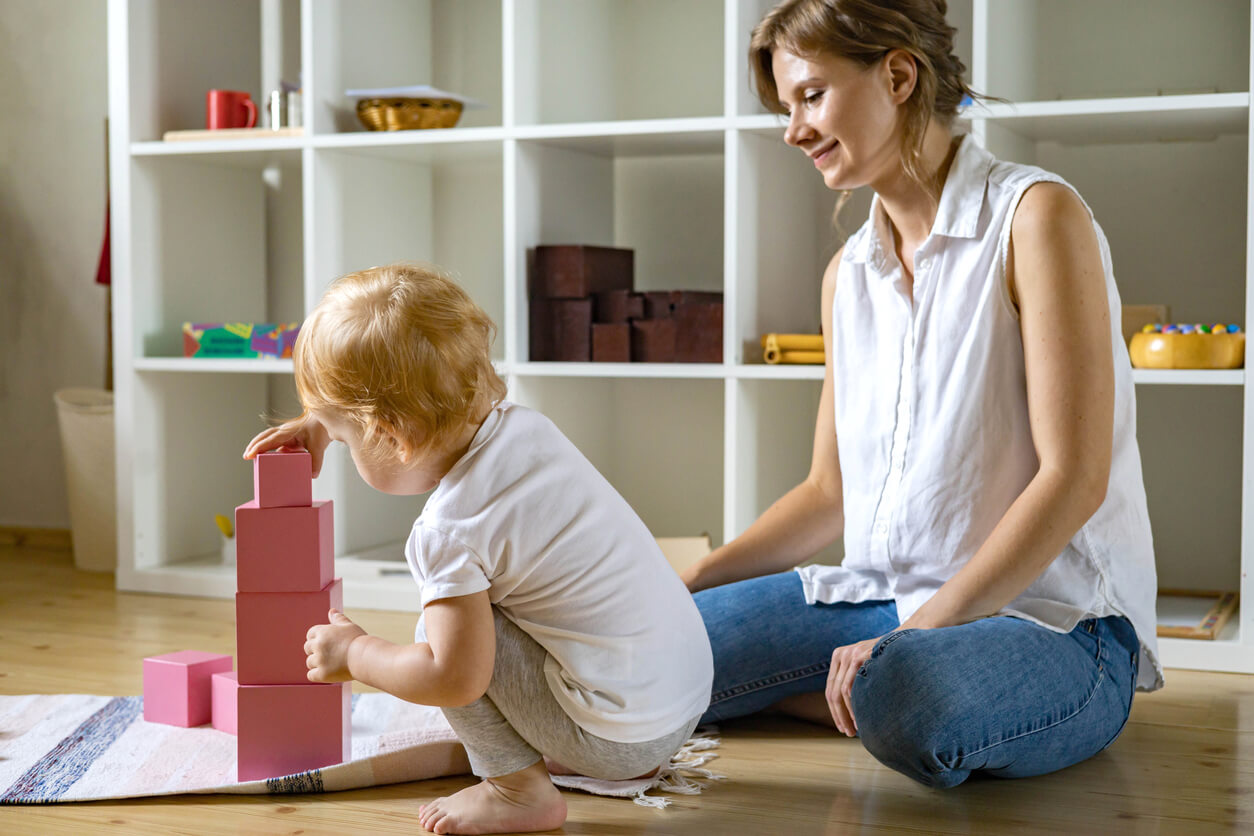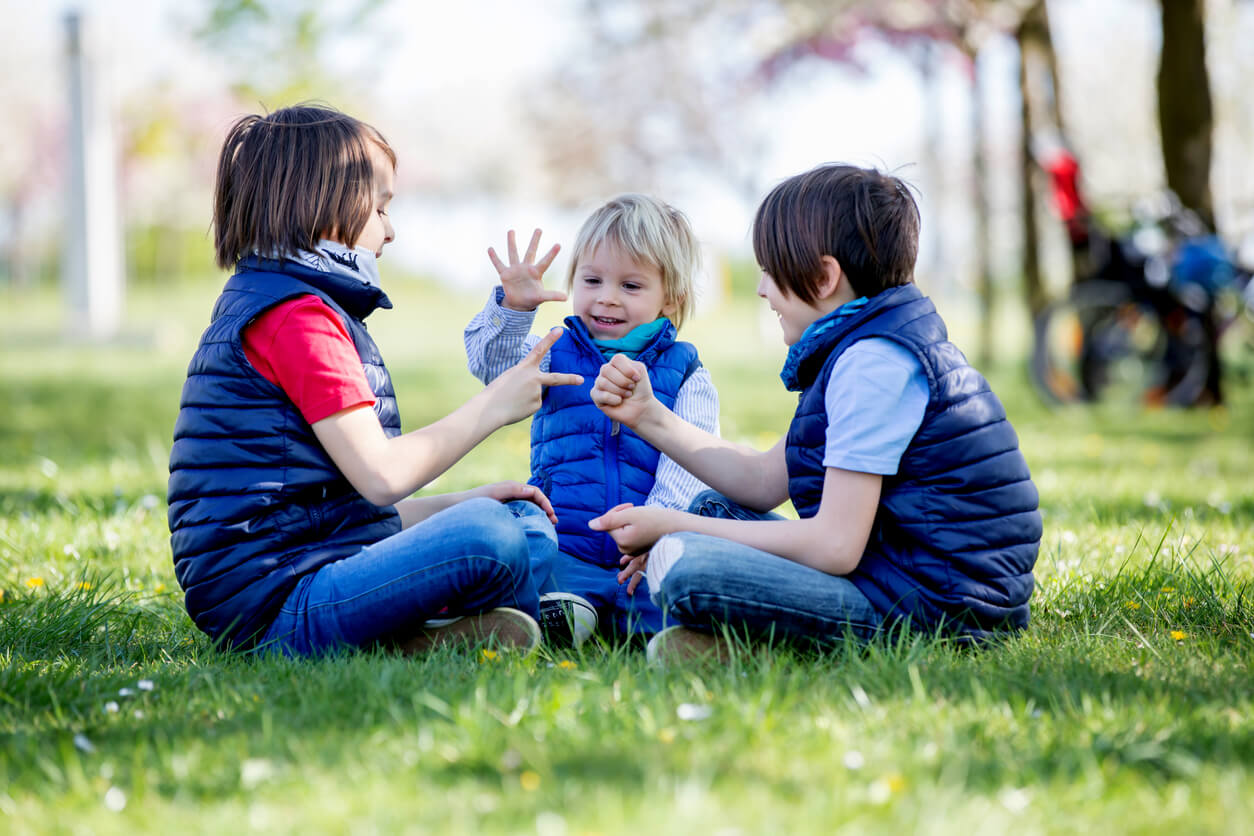The Benefits of the Law of Maximum Effort in Children?

As children cease to be helpless infants and begin to gain more cognitive and motor skills, it’s common to observe that they like to carry things that are heavy or that are bigger than they are. This typical behavior is known as the law of maximum effort and, according to Montessori, it’s a natural stage of children’s psychomotor development.
As they grow and reach new developmental milestones every day, children feel the need to face new goals and continue learning. That’s why, after mastering their first steps, children dare to lift many things, even those that are bigger than them. Something they do as a way to improve themselves every day.
What’s the law of maximum effort about?
Maria Montessori was an Italian pedagogue and physician who dedicated most of her career to children’s pedagogy and the study of children’s physical and emotional development. And, thanks to her wise lessons, millions of parents around the world have had the opportunity to provide their little ones with a better upbringing and education.

In her observation of infant behavior, Montessori concluded that, from one and a half years of age, children acquire great motor skills and agility. This is made possible by the strength and coordination they gain as the months go by. As a result of these feats, children feel strong, and their first impulse is to give maximum effort without help. In Montessori’s words:
The child does not follow the law of the least effort, but a law directly contrary. He uses an immense amount of energy over an unsubstantial end, and he spends, not only driving energy.
What benefits are achieved through the law of maximum effort?
At this stage of childhood, children test their strength, balance, and determination to prove to themselves that they’re capable of doing things that seemed impossible before. And this allows them to continue to practice their first steps and cultivate their self-esteem and confidence. Because of the above, when children are allowed to explore freely, their self-concept and motor development are fostered.

Therefore, when parents observe their children entering this stage of strength and curiosity, they should allow them to experiment and not interrupt their personal growth. As long as they’re not trying to lift an object that’s so heavy that it could hurt them.
To achieve this, it’s crucial to provide children with a safe space where they can venture out and explore without harming their well-being. So, keep dangerous objects such as fire sources, glass furniture, or decorative objects out of their way. This way, you can feel confident that your children can play and strengthen their motor skills.
It’s important to remember that, according to Montessori, excessive error control in the education and upbringing of children can have negative consequences. Because if children are constantly corrected and aren’t allowed to explore the world on their own, it generates a dependence on adults that prevents them from reaching their optimal development.
How can we encourage the law of maximum effort stage?
One of the best attitudes we parents can employ when our children are facing the law of maximum effort stage is not to interfere with the innate development of their abilities. Although we must always make sure that they don’t hurt themselves in their exploration process, of course, while giving them the confidence and security that they’re capable of acquiring more autonomy.
Here are some ways in which you can encourage your children.
1. Motivate them to reach new goals
When parents encourage their children to reach new milestones, the innate motivation that runs through them encourages them to give their maximum effort. And this may mean lifting heavy objects or pushing/moving them from one place to another.
So, when we go to the market, we can ask them to carry a small bag and, when we get home, allow them to help us unpack some of the purchases. This will allow them to feel useful and also to gain new knowledge to always improve and help others.
2. Teach them everyday actions
From learning how to put away the pots to watering the plants with a small watering can, there are many everyday actions that can help children spark their interest and build their self-esteem.
Like putting out a play basket that has a size they can drag and move on their own, playing with a large stuffed animal or ball, or teaching them how to put their dirty clothes in the washing machine or a hamper.
3. Use varied games and dynamics
When you notice that your little one is at that stage where they don’t want help from others and tests their strength every day, help them master their skills through games and dynamics that allow them to move freely and transport objects from one place to another.
In this way, not only are we encouraging their motor development, but we’re also spending quality time with our children. A key component in all positive and secure attachment parenting, which allows little ones to feel motivated and confident to reach new goals.
The law of maximum effort is a key stage
Now that you know more about the law of maximum effort expounded by Maria Montessori, you may understand more about your little ones’ behavior and how they gradually gain more autonomy, freedom, and strength in their bodies.
So, try to motivate your children and give them the affection and emotional security to dare to explore new skills without hurting themselves. In this way, children are allowed to evolve at their own pace and not make them dependent on the extreme care of others.
As children cease to be helpless infants and begin to gain more cognitive and motor skills, it’s common to observe that they like to carry things that are heavy or that are bigger than they are. This typical behavior is known as the law of maximum effort and, according to Montessori, it’s a natural stage of children’s psychomotor development.
As they grow and reach new developmental milestones every day, children feel the need to face new goals and continue learning. That’s why, after mastering their first steps, children dare to lift many things, even those that are bigger than them. Something they do as a way to improve themselves every day.
What’s the law of maximum effort about?
Maria Montessori was an Italian pedagogue and physician who dedicated most of her career to children’s pedagogy and the study of children’s physical and emotional development. And, thanks to her wise lessons, millions of parents around the world have had the opportunity to provide their little ones with a better upbringing and education.

In her observation of infant behavior, Montessori concluded that, from one and a half years of age, children acquire great motor skills and agility. This is made possible by the strength and coordination they gain as the months go by. As a result of these feats, children feel strong, and their first impulse is to give maximum effort without help. In Montessori’s words:
The child does not follow the law of the least effort, but a law directly contrary. He uses an immense amount of energy over an unsubstantial end, and he spends, not only driving energy.
What benefits are achieved through the law of maximum effort?
At this stage of childhood, children test their strength, balance, and determination to prove to themselves that they’re capable of doing things that seemed impossible before. And this allows them to continue to practice their first steps and cultivate their self-esteem and confidence. Because of the above, when children are allowed to explore freely, their self-concept and motor development are fostered.

Therefore, when parents observe their children entering this stage of strength and curiosity, they should allow them to experiment and not interrupt their personal growth. As long as they’re not trying to lift an object that’s so heavy that it could hurt them.
To achieve this, it’s crucial to provide children with a safe space where they can venture out and explore without harming their well-being. So, keep dangerous objects such as fire sources, glass furniture, or decorative objects out of their way. This way, you can feel confident that your children can play and strengthen their motor skills.
It’s important to remember that, according to Montessori, excessive error control in the education and upbringing of children can have negative consequences. Because if children are constantly corrected and aren’t allowed to explore the world on their own, it generates a dependence on adults that prevents them from reaching their optimal development.
How can we encourage the law of maximum effort stage?
One of the best attitudes we parents can employ when our children are facing the law of maximum effort stage is not to interfere with the innate development of their abilities. Although we must always make sure that they don’t hurt themselves in their exploration process, of course, while giving them the confidence and security that they’re capable of acquiring more autonomy.
Here are some ways in which you can encourage your children.
1. Motivate them to reach new goals
When parents encourage their children to reach new milestones, the innate motivation that runs through them encourages them to give their maximum effort. And this may mean lifting heavy objects or pushing/moving them from one place to another.
So, when we go to the market, we can ask them to carry a small bag and, when we get home, allow them to help us unpack some of the purchases. This will allow them to feel useful and also to gain new knowledge to always improve and help others.
2. Teach them everyday actions
From learning how to put away the pots to watering the plants with a small watering can, there are many everyday actions that can help children spark their interest and build their self-esteem.
Like putting out a play basket that has a size they can drag and move on their own, playing with a large stuffed animal or ball, or teaching them how to put their dirty clothes in the washing machine or a hamper.
3. Use varied games and dynamics
When you notice that your little one is at that stage where they don’t want help from others and tests their strength every day, help them master their skills through games and dynamics that allow them to move freely and transport objects from one place to another.
In this way, not only are we encouraging their motor development, but we’re also spending quality time with our children. A key component in all positive and secure attachment parenting, which allows little ones to feel motivated and confident to reach new goals.
The law of maximum effort is a key stage
Now that you know more about the law of maximum effort expounded by Maria Montessori, you may understand more about your little ones’ behavior and how they gradually gain more autonomy, freedom, and strength in their bodies.
So, try to motivate your children and give them the affection and emotional security to dare to explore new skills without hurting themselves. In this way, children are allowed to evolve at their own pace and not make them dependent on the extreme care of others.
All cited sources were thoroughly reviewed by our team to ensure their quality, reliability, currency, and validity. The bibliography of this article was considered reliable and of academic or scientific accuracy.
- Blandón Martínez, E., & Lanzas Sánchez, R. I. (2015). Estimulación oportuna y adecuada para potenciar el desarrollo motriz de los niños y niñas de 9 a 12 meses en la etapa lactantes, del Centro de Desarrollo Infantil “Mildred Abaunza” de la ciudad de Managua, durante el I Semestre del año 2015 (Doctoral dissertation, Universidad Nacional Autónoma de Nicaragua, Managua). Recuperado de: https://repositorio.unan.edu.ni/3263/
- González-Pienda, J. A. (2007). Los retos de la familia hoy ante la educación de sus hijos: a educar también se aprende. Recuperado de: https://ruc.udc.es/dspace/bitstream/handle/2183/7080/RGP_15-13_Cong.pdf
- Lillard, A. S. (2012). Preschool children’s development in classic Montessori, supplemented Montessori, and conventional programs. Journal of School Psychology. Recuperado de: https://doi.org/10.1016/j.jsp.2012.01.001
- Orozco Ocaña, C. P. Albán Tarambis, J. P. Vela Rojas, K. M. (2021). El método Montessori en el desarrollo integral de los niños/as de 4 a 5 años. Recuperado de: http://www.dspace.uce.edu.ec/handle/25000/23725
This text is provided for informational purposes only and does not replace consultation with a professional. If in doubt, consult your specialist.








